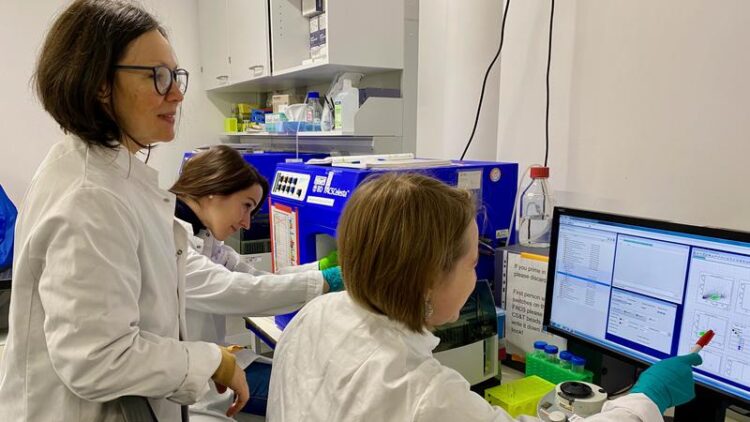Where the HI-Virus sleeps in the brain

Dr Marina Lusic, Mona Rheinberger and Dr Bojana Lucic (from left) investigating the viral infection condition of cells by fluorescence-activated cell sorting.
(c) Heidelberg University Hospital/Marina Lusic
The human immunodeficiency virus HIV-1 is able to infect various tissues in humans. Once inside the cells, the virus integrates its genome into the cellular genome and establishes persistent infections. The role of the structure and organisation of the host genome in HIV-1 infection is not well understood. Using a cell culture model based on brain immune microglia cells, an international research team led by scientists from Heidelberg University Hospital and the German Center for Infection Research (DZIF) now defined the insertion patterns of HIV-1 in the genome of microglia cells.
An infection with the human immunodeficiency virus (HIV) is in 99,9% of cases still an incurable disease. This is because the virus “sleeps” for a long time in the genome of infected cells, making it invisible and inaccessible to the immune system and antiviral drugs. The pathways that HIV-1 takes to remain hidden in the host cell genome have been studied primarily in blood CD4+ T cells—the main target cells of the virus. However, HIV-1 is capable of infecting other immune cells in different organs, where it establishes stable reservoirs. One such viral sanctuary is the brain, where the virus infects mostly microglia immune cells, often causing neuroinflammation and symptoms of HIV-1 associated neurocognitive disorder (HAND).
Questions related to HIV-1 infection and replication in the brain have been very difficult to resolve because studies in patients are limited in their ability to monitor the virus in the brain. An international team led by Dr Marina Lusic from Heidelberg University Hospital and the DZIF now succeeded in developing HIV-1-infection models in human microglia cell cultures. Establishment of the models allowed for the first time to investigate the insertion of the HIV-1 genome in that of microglia cells. Genomic insertion results in the silencing of the viral genome, leading to the so-called “sleeping virus” phenotype.
The researchers, who recently published their findings in the renowned scientific journal Cell Reports, used the microglia cell models to determine HIV-1 integration sites and associate them with structural and regulatory elements of the chromatin.
“Modelling HIV-1-infections of the brain immune cells using the microglia cell cultures, we discovered a stronger correlation between a cellular chromatin factor and the sleeping virus phenotype,” says the paper’s first author Mona Rheinberger. “This protein, called CTCF, is one of the most important architectural proteins of the cellular genome, involved in chromatin folding and packaging inside the cells. Our findings indicate that CTCF is shaping the HIV-1 genomic insertion profiles in microglia, thus contributing to the latent infection state.”
“These studies in cell culture models are extremely important to understand how the virus can be targeted in different parts of the body, where it can remain hidden or cause neurological disorders even under current therapeutic regimens,” Dr Lusic concludes.
Wissenschaftliche Ansprechpartner:
Dr. Marina Lusic
Heidelberg University Hospital
marina.lusic[at]med.uni-heidelberg.de
Originalpublikation:
Genomic profiling of HIV-1 integration in microglia cells links viral integration to the topologically associated domains, Cell Reports, 2023, DOI: 10.1016/j.celrep.2023.112110
Weitere Informationen:
https://www.dzif.de/en/where-hi-virus-sleeps-brain DZIF press release
Media Contact
All latest news from the category: Life Sciences and Chemistry
Articles and reports from the Life Sciences and chemistry area deal with applied and basic research into modern biology, chemistry and human medicine.
Valuable information can be found on a range of life sciences fields including bacteriology, biochemistry, bionics, bioinformatics, biophysics, biotechnology, genetics, geobotany, human biology, marine biology, microbiology, molecular biology, cellular biology, zoology, bioinorganic chemistry, microchemistry and environmental chemistry.
Newest articles

First-of-its-kind study uses remote sensing to monitor plastic debris in rivers and lakes
Remote sensing creates a cost-effective solution to monitoring plastic pollution. A first-of-its-kind study from researchers at the University of Minnesota Twin Cities shows how remote sensing can help monitor and…

Laser-based artificial neuron mimics nerve cell functions at lightning speed
With a processing speed a billion times faster than nature, chip-based laser neuron could help advance AI tasks such as pattern recognition and sequence prediction. Researchers have developed a laser-based…

Optimising the processing of plastic waste
Just one look in the yellow bin reveals a colourful jumble of different types of plastic. However, the purer and more uniform plastic waste is, the easier it is to…



